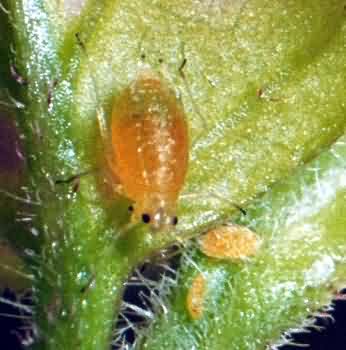Pests
Myzodes persicae Sulz. - Peach-Potato Aphid.
Systematic position.
Class Insecta, order Homoptera, suborder Aphidinea, superfamily Aphidoidea, family Aphididae, subfamily Aphidinae, tribe Macrosiphini, subtribe Macrosiphina, genus Myzodes.Synonym.
Myzus persicae Sulz.Biological group.
Polyphagous pest.Morphology and biology.
Green, yellow or pink fusiform body of apterous female reaches 2.5 mm. Antennal tubercles high, forming frontal groove. Antenna has six articles. Siphunculi cylindrical, with basal swelling, 1/4 body length, 3 times as long as yellow fingerlike cauda. Body length of winged female reaches 2 mm. Insect has brown head, black thorax, and green abdomen with black transverse stripes; antennae are black. Siphunculi are 2 times as long as cauda. Oval eggs are black. There are both holocyclic (Middle Asia, Kazakhstan) and anholocyclic (very widespread) races of the insect. Holocyclic aphids over-winter during the egg phase on primary host (peach, apricot, apple, cherry, and plum trees). Anholocyclic aphids over-winter during the adult phase (apterous and winged parthenogenetic females), on wild plants. In the zone of strong damage the hatching of fundatrices larvae is observed in the middle of April. Fundatrice live 24 days, its fecundity is 60-80 larvae. At the end of May winged females migrate to young leaves of the same hosts. On peach and apricot trees the pest produces up to 3 generations. Damaged leaves become yellow then they bend and dry. Then the aphids migrate to secondary hosts, such as tobacco, potato, tomato, pepper, and other plants. Especially intensive migrations take place in the middle of July; on tobacco the migration lasts until mid-August, although single migrations occur in September. Aphids prefer young leaves, feeding on lower side along veins. They form big colonies. Life span of apterous parthenogenetic female is 20-25 days and its fecundity reaches 100 larvae. The larval period lasts 5-11 days. When the leaves become mature, the insects (abholocyclic form) migrate to wild plants. The pests feed on these plants until mid-November. Here they over-winter. Virginoparae of the holocyclic race appear at the beginning of September when they migrate to primary host-plant. In November females and males copulate; fecundation takes place; eggs are laid in groups (2-7 eggs) near flower buds under scales of bark on young twigs.Distribution.
The species is widespread in Europe, Asia, North and West America, Africa. Within the territory of the Former Soviet Union the anholocyclic form is marked in the Caucasus, Transcaucasia, Ukraine, Moldova, Central Black Earth zone, West Siberia, in the Altai. Some records are known in the North-Western region of Russia, in Primorskii Territory. The highest harmful activity is reported in Middle Asia, Kazakhstan, Transcaucasia (holocyclic form).Ecology.
The aphids of the holocyclic form are not cold-resistant. At the temperature of 6°C the females perish. The insects of the anholocyclic form are considerably more cold-resistant. The hatching of fundatrices larvae is observed at temperatures of 13-14°C. The maximum aphids' numbers occurs in the second half of June on peach and apricot trees; in August on tobacco. The most favorable conditions for the species are temperatures of 25-28°C and relative humidity of 80-85%. Within the territory of the Former Soviet Union the species produces 16 generations during a year. The most important predators include Coccinella septempunctata L., C. quinquepunctata L., Adalia bipunctata L., Adonia variegate Goeze, Propylaea quatuordecimpunctata L., Syrphus corollae F., S. balteatus Deg., Chrysopa vulgaris Schn., C. perla L., Ephedrus plagiator Nees., Aphidencyrtus aphidivorus Mayr.Economic significance.
The pest causes the greatest damage to peach and apricot trees and tobacco. It feeds on potato, tomato, cabbage, pepper, egg-plant, cucumber, water-melon, beet, carrot, sunflower, radish, cotton, apple, cherry and plum trees, and many other plants. The insect has more than 200 host-plants. Control measures include timely forecasting of the pest appearance and number, eradication of weeds, insecticide treatments at the end of May, in June, July, and August.Reference citations:
Akhmedov M.Kh., Mustafakulov Kh.T. 1984. About ecological features of peach-potato aphid in the south-east of Middle Asia. Proceedings of Vitebsk Pedagogical Institute. Part II. Vitebsk. 195-6 p. (In Russian)Anayan R.N. 1950. The biology of peach-potato aphid - tobacco pest in Armenian SSR and its control. In: Karagezyan S.M., ed. Proceedings of Armenian Research Institute of technical cultures 3. Erevan. 127-37 p. (In Russian)
Bundzhe Z.F. 1972. About harmfulness of peach-potato aphid. In: Kaipov A.D., ed. Proceedings of conference of young scientists. Alma-Ata: AN KazakhSSR. 628-9 p. (In Russian)
Bundzhe Z.F. 1975. To biology of peach-potato aphid on tobacco. In: Dzhiembaev Zh.T., ed. Protection of vegetable, food and technical cultures from pests, diseases and weeds. V. XIII. Alma-Ata: Kainar. 134-7 p. (In Russian)
Gainulina R.G., Smolich I.P. 1974. The aphid on potato fields. Zashchita rastenii, 5: 48. (In Russian)
Khrameeva A.V., Toman G.A. 1988. The influence of ecological factors on peach-potato aphid (Myzus persicae Sulzer) popoulation dynamics. In: Klampinya A.E., ed. The biological regulation of harmful arthropods popoulation. Riga: Zinatne. 68-86 p. (In Russian)
Leont'eva Yu. A., Gerasimov B.S., Mikhailov A.A. 1969. The peach-potato aphid on potatoes. Zashchita rastenii, 2: 50. (In Russian)
Migulin A.A., ed. 1983. Agricultural entomology. Moscow: Kolos. 190-1 p. (In Russian)
Mukhamediev A.A. 1978. The pea-potato aphid and factors that decrease its harmfulness in the agrobiocenosis of tobacco. Uzbekskii biologicheskii zhurnal, 4: 65-7. (In Russian)
Statkov M.G., Ivanov E.G. 1988. The influence of peach-potato aphid on tobacco quality during its drying. In: Kogan I.S., ed. The production and industrial processing of tobacco for research-technical integration conditions. Kishinev: Shtiintsa. 53-4 p. (In Russian)
Stolyarov M.V., Bardzhadze L.A. Dynamics of peach-potato aphid harmfulness (Myzus persicae) in West Georgia. In: Medvedev G.S., ed. Proceedings of X VEO Congress. St. Petersburg: RAN. 154-5 p. (In Russian)
Taimanov Sh.I. 1984. Harmfulness of peach-potato aphid (Myzodes persicae Sulz.) on tobacco in Zeravshan valley of Tajikistan. In: Vasil'ev V.P., ed. Proceedings of IX VEO Congress. Part II. Kiev: Naukova dumka. 183 p. (In Russian)


